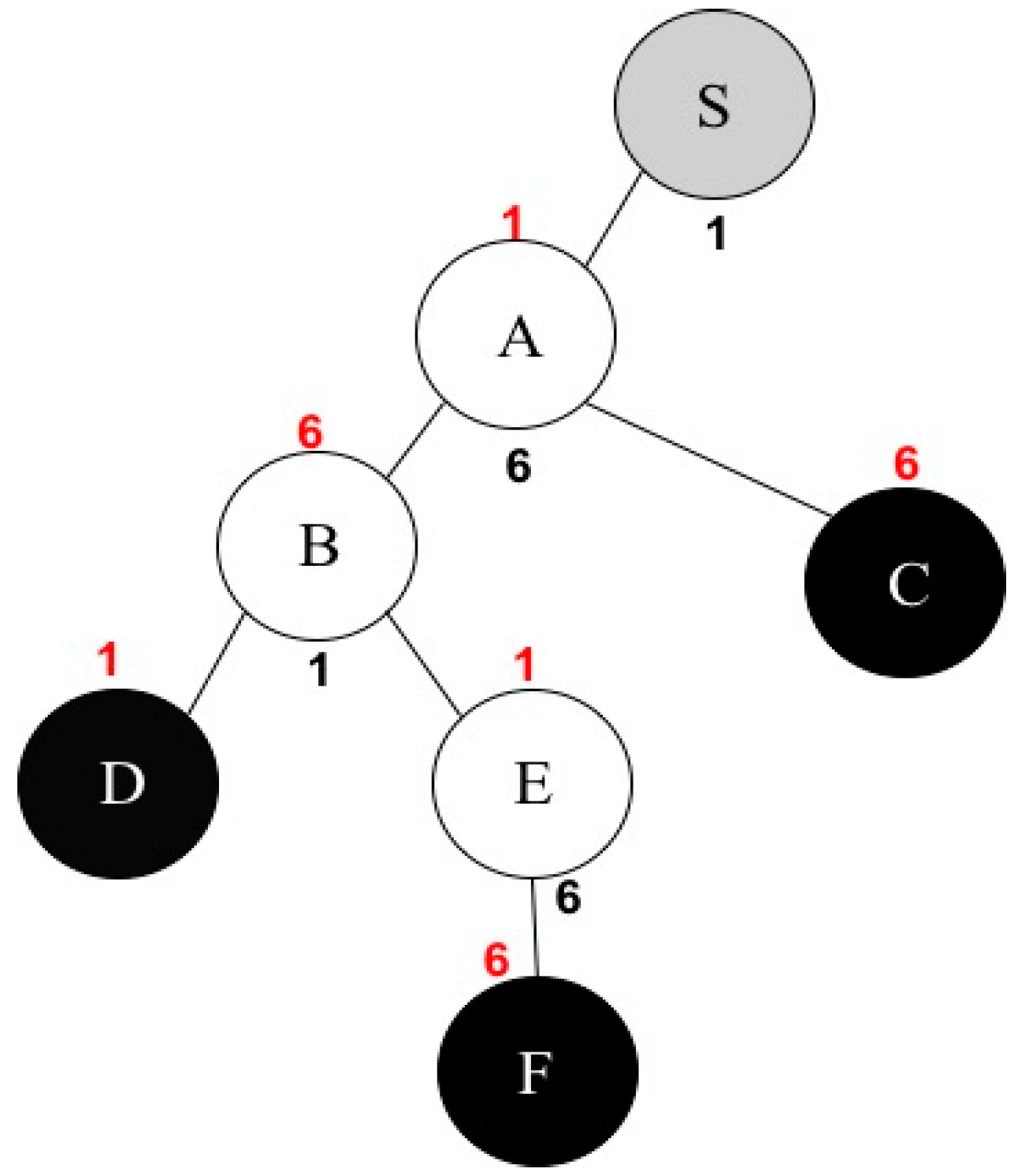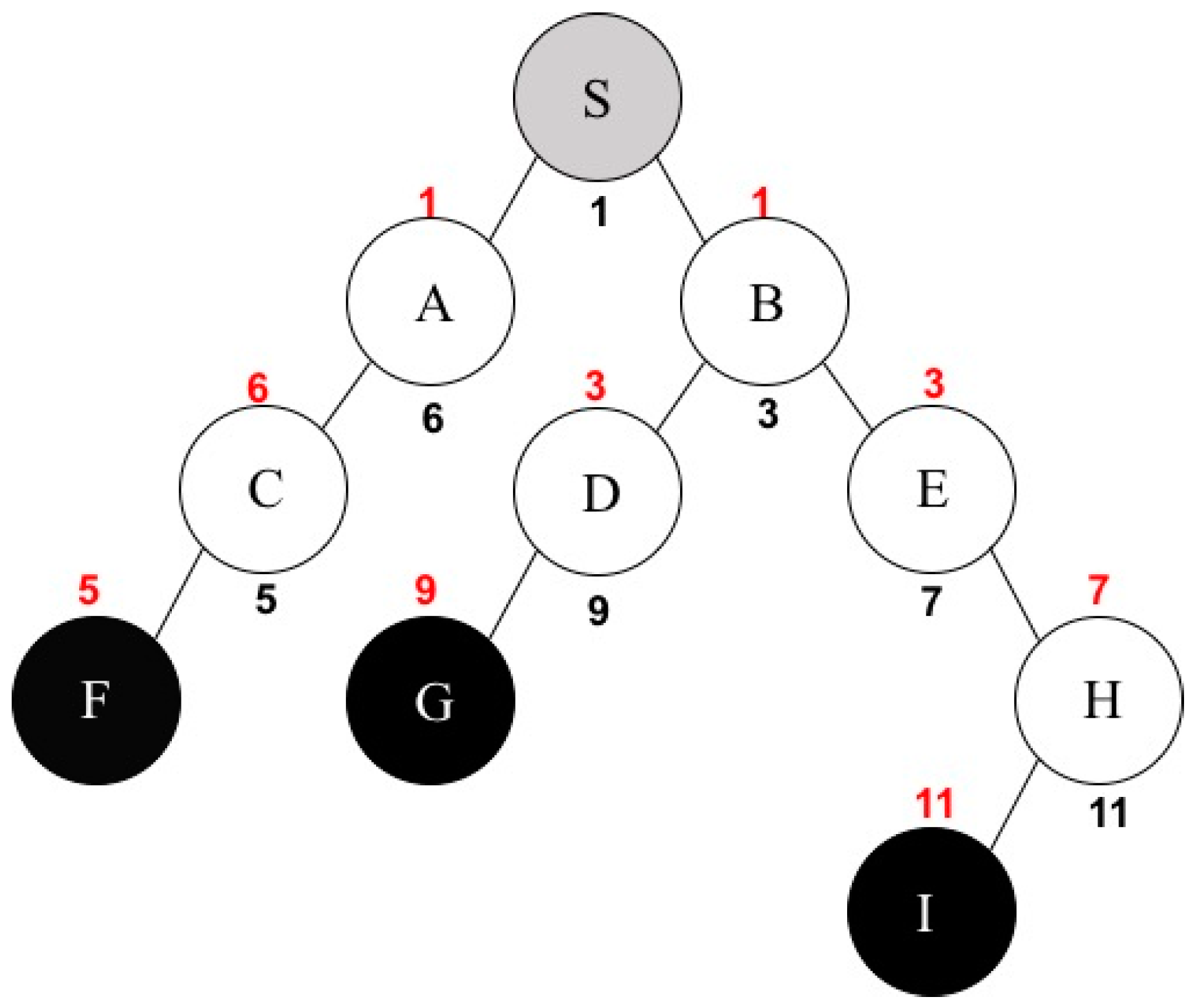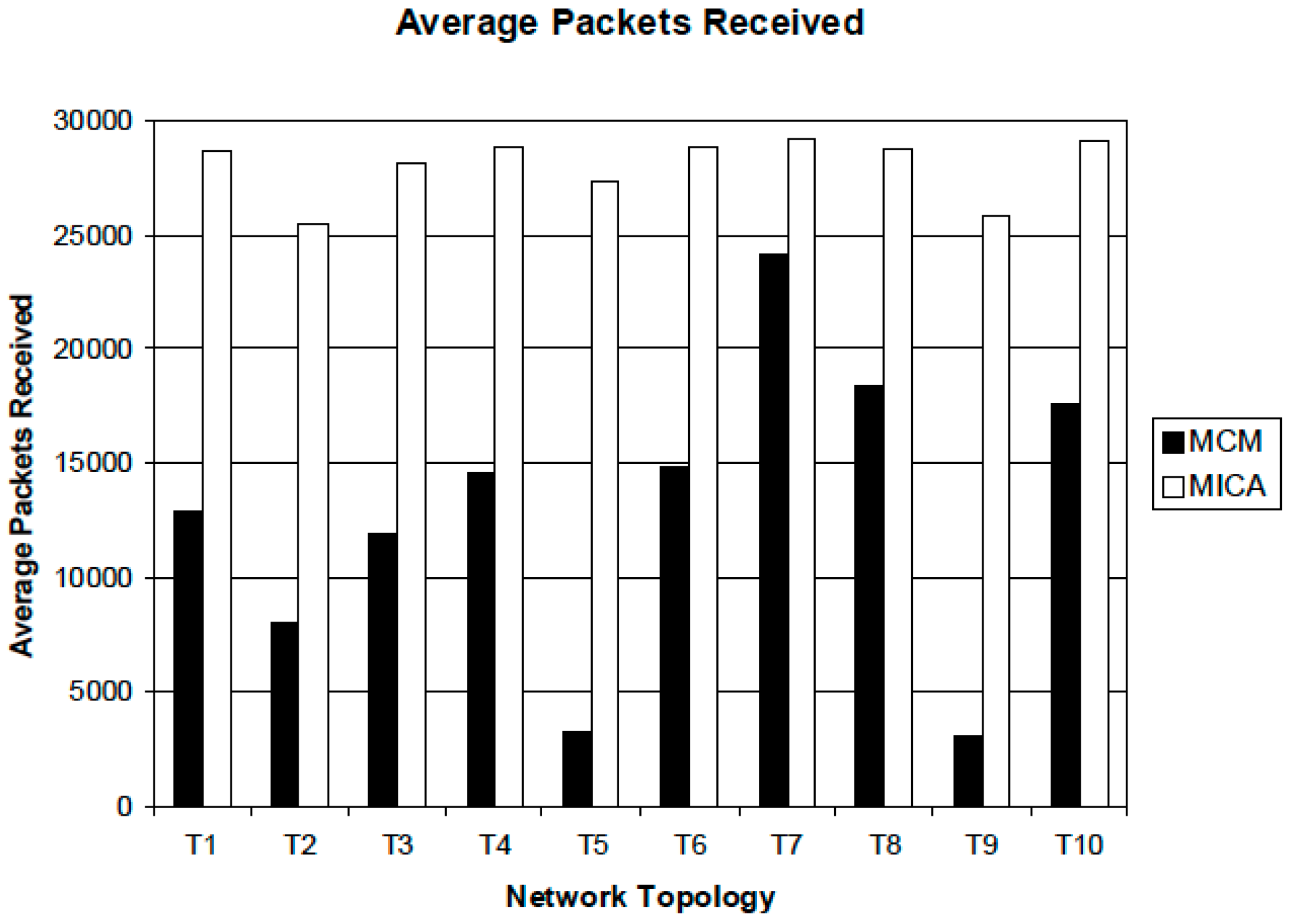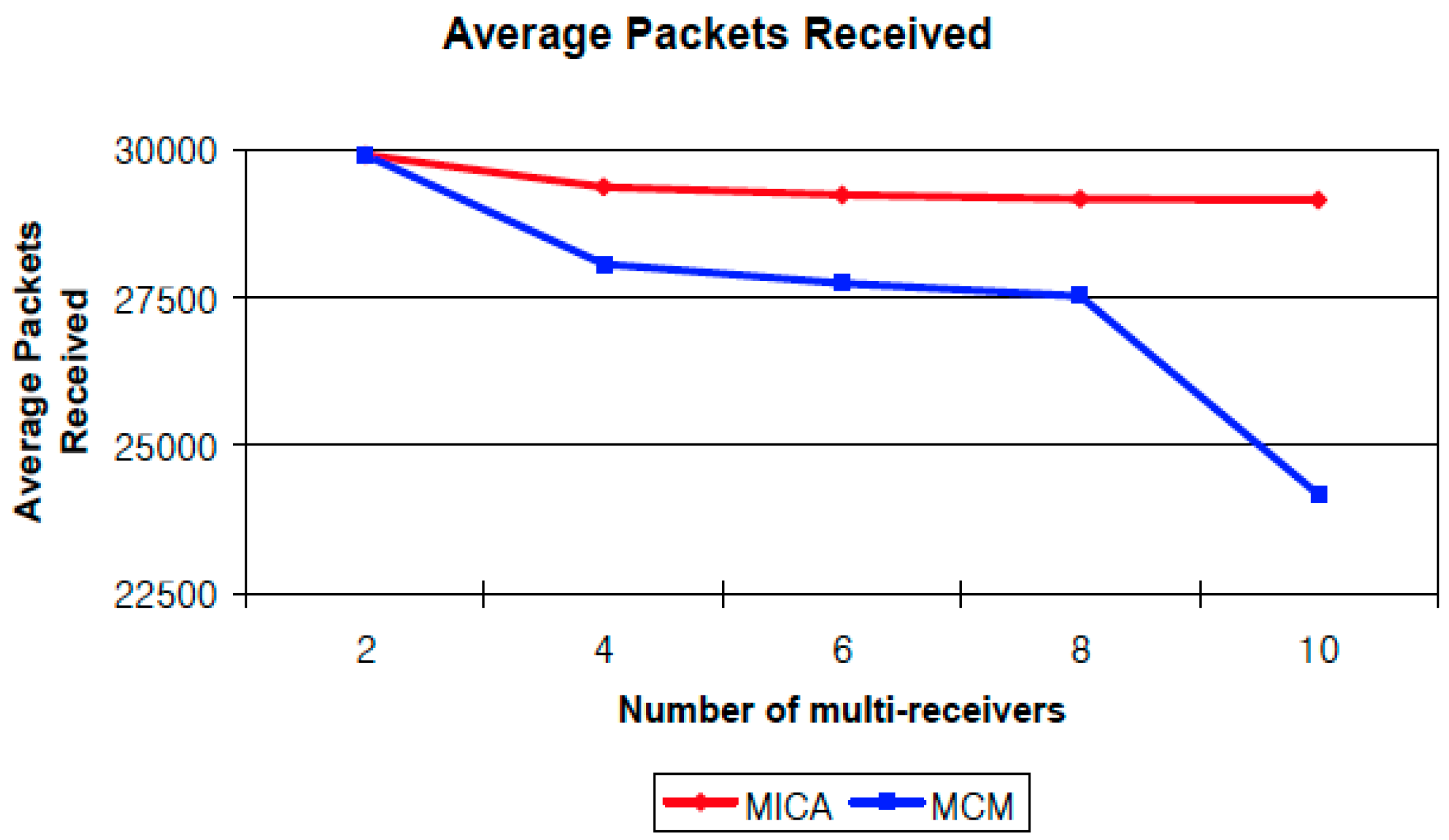Minimum Interference Channel Assignment Algorithm for Multicast in a Wireless Mesh Network
Abstract
:1. Introduction
2. Related Work
3. Minimum Interference Channel Assignment
3.1. Calculating a Channel Separation of All Pairs of Nodes
| Algorithm 1: Calculating Channel Separation |
| 1: input: T, a multicast tree 2: output: CS<u, v>, the channel separation of all pairs of nodes in T 3: procedure CALCULATING THE CHANNEL SEPARATION OF ALL PAIRS OF NODES 4: for each pair of nodes (u, v) 5: Cu ← the set of u’s children 6: Cv ← the set of v’s children 7: MAXu ← 0 8: MAXv ← 0 9: for each node iu Cu do 10: CS<v, iu> ← channel separation between v and iu 11: MAXv ← a maximum value between MAXv and CS<v, iu> 12: end 13: for each node iv Cv do 14: CS<u, iv> ← channel separation between u and iv 15: MAXu ← a maximum value between MAXu and CS<u, iv> 16: end 17: CS<u, v> ← a maximum value between MAXu and MAXv 18: end |
3.2. Finding Channel Separation of Zero
| Algorithm 2: Finding Channel Separation of Zero |
| 1: input: T, a multicast tree 2: CS<u, v>, the channel separation of all pairs of nodes in T 3: output: SD, the set of nodes with a channel number for their sending interface 4: SN, the set of nodes without a channel number for their sending interface 5: procedure FINDING CHANNEL SEPARATION OF ZERO 6: for each pair of nodes (u, v) 7: if CS<u, v> == 0 then 8: sending interface of u ← channel number 6 9: sending interface of v ← channel number 6 10: SD ← u, v 11: SN ← all nodes except (u, v) in T 12: break 13: end 14: end 15: if SD then 16: for each node i SN do 17: if CS<i, j> == 0 for all j SD then 18: sending interface of i ← channel number 6 19: remove i from SN 20: SD ← i 21: end 22: end 23: else 24: find u, v T such that CS<u, v> is a maximum 25: sending interface of u ← channel number 6 26: sending interface of v ← channel number 6 + CS<u, v> 27: SD ← u, v 28: SN ← all nodes except except (u, v) in T 29: end |
3.3. Assigning a Channel Number to All Nodes
| Algorithm 3: Assigning a Channel Number to All Nodes |
| 1: input: T, a multicast tree 2: SD, the set of nodes with a channel number for their sending interface 3: SN, the set of nodes without a channel number for their sending interface 4: output: Channel assignment for all network interfaces 5: CS<u, v>: the channel separation of all pairs of nodes in T 6: CHi: a channel number for node i 7: CONDj: the set of conditions for deciding a channel number of node j 8: procedure ASSIGNING A CHANNEL NUMBER 9: while SN 10: find x SN, y SD such that CS<x, y> is a maximum 11: for each node k SD do 12: CONDx ← [CHx >= CHk + CS<x, k> or CHx <= CHk – CS<x, k>] 13: eliminate all invalid channel numbers 14: ← CONDx conflict conditions 15: select CHx that satisfies all conditions 16: end 17: x ← CHx 18: remove x from SN 19: SD ← x 20: end |
4. Simulations
4.1. Performance Metrics
- Average packet: an average packet is defined as the average number of packets that each multi-receiver receives successfully during the simulation time.
- Average delay: an average delay is the average time taken for a packet to be transmitted across a network from source to destination.
- Standard deviation: the standard deviation is the variability or dispersion of packets received by all multi-receivers.
4.2. Simulation Parameters
4.3. Simulation Results
5. Conclusions
Acknowledgments
Author Contributions
Conflicts of Interest
References
- Akyildiz, I.F.; Wang, X.; Wang, W. Wireless Mesh Networks: A Survey. Elsevier Comput. Netw. 2005, 47, 445–487. [Google Scholar] [CrossRef]
- Stojmenovic, I. Machine-to-machine communications with in-network data aggregation, processing, and actuation for large-scale cyber-physical systems. IEEE Internet Things J. 2014, 1, 122–128. [Google Scholar] [CrossRef]
- Perera, C.; Zaslavsky, A.; Christen, P.; Georgakopoulos, D. Context aware computing for the internet of things: A survey. IEEE Commun. Surv. Tutor. J. 2014, 16, 414–454. [Google Scholar] [CrossRef]
- Dohler, M.; Anton-Haro, C. Machine-to-Machine (M2M) Communications—Architecture, Performance and Applications; Woodhead Publishing: Cambridge, UK, 2015. [Google Scholar]
- Alicherry, M.; Bhatia, R.; Li, L. Joint channel assignment and routing for throughput optimization in multi-radio wireless mesh networks. In Proceedings of the ACM SIGMOBILE, Cologne, Germany, 28 August–2 September 2005.
- Das, A.K.; Alazemi, H.M.K.; Vijayakumar, R.; Roy, S. Optimization models for fixed channel assignment in wireless mesh networks with multiple radios. In Proceedings of the IEEE SECON, Santa Clara, CA, USA, 26–29 September 2005.
- Kodialam, M.; Nandagopal, T. Characterizing the capacity region in multi-radio multi-channel wireless mesh networks. In Proceedings of the ACM MOBICOM, Cologne, Germany, 28 August–2 September 2005.
- Marina, M.K.; Das, S.R. A topology control approach for utilizing multiple channels in multi-radio wireless mesh networks. In Proceedings of the IEEE BROADNETS, Boston, MA, USA, 3–7 October 2005.
- Ramachandran, K.N.; Belding, E.M.; Almeroth, K.C.; Buddhikot, M.M. Interference-aware channel assignment in multi-radio wireless mesh networks. In Proceedings of the IEEE INFOCOM, Barcelona, Spain, 23–29 April 2006.
- Raman, B. Channel allocation in 802.11-based mesh networks. In Proceedings of the IEEE INFOCOM, Barcelona, Spain, 23–29 April 2006.
- Raniwala, A.; Chiueh, T. Architecture and algorithms for an IEEE 802.11-based multi-channel wireless mesh network. In Proceedings of the IEEE INFOCOM, Miami, FL, USA, 13–17 March 2005.
- Raniwala, A.; Gopalan, K.; Chiueh, T. Centralized channel assignment and routing algorithms for multi-channel wireless mesh networks. In Proceedings of the ACM SIGMOBILE, Philadelphia, PA, USA, 26 September–1 October 2004.
- Subramanian, A.P.; Gupta, H.; Das, S.R. Minimum interference channel assignment in multi-radio wireless mesh networks. In Proceedings of the IEEE SECON, San Diego, CA, USA, 18–21 June 2007.
- Tang, J.; Xue, G.; Zhang, W. Interference-aware topology control and QoS routing in multi-channel wireless mesh networks. In Proceedings of the ACM SIGMOBILE, Cologne, Germany, 28 August–2 September 2005.
- Nguyen, H.L.; Nguyen, U.T. Channel assignment for multicast in multi-channel multi-radio wireless mesh networks. Wirel. Commun. Mob. Comput. 2009, 9, 557–571. [Google Scholar]
- Yin, Z.; Li, Z.; Chen, M. A novel channel assignment algorithm for multicast in multi-radio wireless mesh networks. In Proceedings of the IEEE ICNP, Beijing, China, 16–19 October 2007.
- Zeng, G.; Wang, B.; Ding, Y.; Xiao, L.; Mutka, M. Efficient multicast algorithms for multi-channel wireless mesh networks. IEEE Trans. Parallel Distrib. Syst. 2010, 21, 86–99. [Google Scholar] [CrossRef]
- Jahanshahi, M.; Dehghan, M.; Meybodi, M.R. On channel assignment and multicast routing in multi-channel multi-radio wireless mesh networks. Int. J. Ad Hoc Ubiquitous Comput. 2013, 12, 225–244. [Google Scholar] [CrossRef]
- Chiu, H.S.; Yeung, K.L. Maximizing multicast call acceptance rate in multi-channel multi-interface wireless mesh networks. IEEE Trans. Wirel. Commun. 2010, 9, 2622–2631. [Google Scholar] [CrossRef] [Green Version]
- Yang, W.-L.; Kao, C.-C.; Tung, C.-H. Heuristic algorithms for constructing interference-free and delay-constrained multicast trees for wireless mesh networks. KSII Trans. Internet Inf. Syst. 2011, 5, 269–286. [Google Scholar] [CrossRef]
- Karimi, O.B.; Liu, J.; Li, Z. Multicast with cooperative gateways in multi-channel wireless mesh networks. Ad Hoc Netw. 2014, 13, 170–180. [Google Scholar] [CrossRef]
- Ding, Y.; Huang, Y.; Zeng, G.; Xiao, L. Using partially overlapping channels to improve throughput in wireless mesh networks. IEEE Trans. Mob. Comput. 2012, 11, 1720–1733. [Google Scholar] [CrossRef]
- Gaaloul, F.; Radaydeh, R.M.; Alouini, M.-S. Performance improvement of switched-based interference mitigation for channel assignment in over-loaded small-cell networks. IEEE Trans. Wirel. Commun. 2013, 12, 2091–2103. [Google Scholar] [CrossRef]
- Chandrasekhar, V.; Andrews, J.G.; Muharemovic, T.; Shen, Z. Power Control in Two-Tier Femtocell Networks. IEEE Trans. Wirel. Commun. 2009, 8, 4316–4328. [Google Scholar] [CrossRef]
- Liu, D.; Zhang, H.; Zheng, W.; Wen, X. The sub-channel allocation algorithm in femtocell networks based on ant colony optimization. In Proceedings of the Military Communications Conference (MILCOM 2012), Orlando, FL, USA, 29 October–1 November 2012.
- Zhang, W.; Jiang, C.; Beaulieu, C.N.; Chu, X.; Wen, X.; Tao, M. Resource allocation in spectrum-sharing OFDMA femtocells with heterogeneous service. IEEE Trans. Commun. 2014, 62, 2366–2377. [Google Scholar] [CrossRef]
- Zhang, W.; Xing, H.; Cheng, J.; Nallanathan, A.; Leung, V.C.M. Secure Resource allocation for OFDMA two-way relay wireless sensor networks without and with cooperative jamming. IEEE Trans. Ind. Inform. 2016, 12, 1714–1725. [Google Scholar] [CrossRef]
- Zhang, W.; Jiang, C.; Beaulieu, C.N.; Chu, X.; Wang, X.; Quek, T.Q.S. Resource allocation for cognitive small cell networks: A cooperative bargaining game theoretic approach. IEEE Trans. Wirel. Commun. 2015, 6, 3481–3493. [Google Scholar] [CrossRef]
- Mishra, A.; Rozner, E.; Banerjee, S.; Arbaugh, W. Exploiting partially overlapping channels in wireless networks: Turning a peril into an advantage. In Proceedings of the IMC, Berkeley, CA, USA, 19–21 October 2005.
- Qualnet. Available online: http://web.scalable-networks.com/content/qualnet (accessed on 8 August 2016).
- Lee, S.J.; Gerla, M.; Chiang, C.C. On-demand multicast routing protocol. In Proceedings of the IEEE WCNC’99, New Orleans, LA, USA, 21–25 September 1999.
- Distance Vector Multicast Routing Protocol. Available online: http://www.networksorcery.com/enp/rfc/rfc1075.txt (accessed on 8 August 2016).
- Multicast Extensions to OSPF. Available online: http://www.networksorcery.com/enp/rfc/rfc1584.txt (accessed on 8 August 2016).
- Royer, E.M.; Perkins, C.E. Multicast operation of the ad-hoc on-demand distance vector routing protocol. In Proceedings of the ACM MOBICOM, Seattle, WA, USA, 15–20 August 1999.







| Channel Separation | 2 Mbits/s | 5.5 Mbits/s | 11 Mbits/s |
|---|---|---|---|
| 0 | 2.5 | 2.2 | 2.0 |
| 1 | 1.6 | 1.5 | 1.2 |
| 2 | 1.2 | 1.0 | 0.7 |
| 3 | 0.9 | 0.8 | 0.5 |
| 4 | 0.5 | 0.3 | 0.2 |
| 5 | 0.0 | 0.0 | 0.0 |
| Parameter | Value |
|---|---|
| Number of channels used | 11 |
| Network size | 30 nodes over 900 m 900 m |
| Transmission range | 250 m |
| Transmission rate at a physical layer | 11 Mbits/s |
| Physical layer protocol | IEEE PHY 802.11b |
| Multicast routing protocol | MOSPF |
| Packet size | 512 bytes |
| Transmission rate at an application layer | 100 packets/s |
| Traffic model | MCBR |
| Simulation time | 300 s |
© 2016 by the authors; licensee MDPI, Basel, Switzerland. This article is an open access article distributed under the terms and conditions of the Creative Commons Attribution (CC-BY) license (http://creativecommons.org/licenses/by/4.0/).
Share and Cite
Choi, S.; Park, J.H. Minimum Interference Channel Assignment Algorithm for Multicast in a Wireless Mesh Network. Sensors 2016, 16, 2056. https://doi.org/10.3390/s16122056
Choi S, Park JH. Minimum Interference Channel Assignment Algorithm for Multicast in a Wireless Mesh Network. Sensors. 2016; 16(12):2056. https://doi.org/10.3390/s16122056
Chicago/Turabian StyleChoi, Sangil, and Jong Hyuk Park. 2016. "Minimum Interference Channel Assignment Algorithm for Multicast in a Wireless Mesh Network" Sensors 16, no. 12: 2056. https://doi.org/10.3390/s16122056
APA StyleChoi, S., & Park, J. H. (2016). Minimum Interference Channel Assignment Algorithm for Multicast in a Wireless Mesh Network. Sensors, 16(12), 2056. https://doi.org/10.3390/s16122056




_Park.png)


